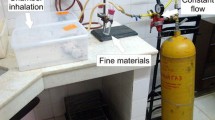Abstract
Methylthioketobutyric acid has been used as an indicator for the production of reactive oxygen species during incubation with xanthine oxidase or NADH diaphorase in the presence of an autooxidizable quinone. The production of OH-radical-type oxidants is enhanced in the presence of crocidolite but not by the asbestos types chrysotile or amosite. This activity of crocidolite in the diaphorase system is further stimulated by bisulfite. Crocidolite-dependent ethylene formation from methylthioketobutyric acid is inhibited by both superoxide dismutase and catalase. In the presence of both crocidolite and bisulfite, however, the inhibition by superoxide dismutase is preserved, but the inhibition by catalase is lost. Since in some respect the NADH-diaphorase quinone system may reflect the situation in the activated macrophage, crocidolite activation may represent a biochemical model system describing potential asbestos toxicity.
Similar content being viewed by others
Abbreviations
- SOD:
-
Superoxide dismutase
- KMB:
-
methylthioketobutyrate
- XOD:
-
xanthine oxidase
References
Buettner GR (1987) Activation of oxygen by metal complexes and its relevance to autoxidative processes in living systems. Bioelectrochemistry and Bioenergetics 18: 29–36
Chance B, Sies H, Boveris A (1979) Hydroperoxide metabolism in mammalian organs. Physiol Rev 59: 527–605
Elstner EF, Schütz W, Vogl G (1986) Enhancement of enzymecatalyzed production of reactive oxygen species by suspensions of “Crocidolite” asbestos fibers. Free Rad Res Commun 1: 355–359
Graceffa P, Weitzman SA (1987) Asbestos catalyzes the formation of the 6-oxobenzol(a)pyrene radical from 6-hydroxybenzo(a)pyrene. Arch Biochem Biophys 257: 481–484
Jackson JH, Schraufstatter IU, Hyslop PA, Vosbeck K, Sauerheber S, Weitzman SA, Cochrane CG (1987) Role of oxidants in DNA damage — hydroxyl radical mediates the synergistic DNA damaging effects of asbestos and cigarette smoke. J Clin Invest 80: 1090–1095
Mossman B, Landesman JM (1983) Importance of oxygen free radicals in asbestos-induced injury to airway epithelial cells. Chest 83: 50s-51s
Mossman B, Light W, Wei E (1983) Asbestos: mechanisms of toxicity and carcinogenicity in the respiratory tract. Ann Rev Pharmacol Toxicol 23: 595–615
Mottley C, Mason RP, Chignell CF, Sivarajah K, Eling TE (1982) The formation of sulfur trioxide radical anion during the prostaglandin hydroperoxidase — catalyzed oxidation of bisulfite (hydrated sulfur dioxide). J Biol Chem 257: 5050–5055
Peiser GD, Yang SF (1978) Chlorophyll destruction in the presence of bisulfite and linolenic acid hydroperoxide. Phytochemistry 17: 79–84
Selikoff IJ, Lee DHK (eds) (1978) Asbestos and disease. Academic Press, New York
Weitzman SA, Graceffa P (1984) Asbestos catalyzes hydroxyl and superoxide radical generation from hydrogen peroxide. Arch Biochem Biophys 228: 373–376
Youngman RJ, Osswald WF, Elstner EF (1982) Mechanisms of oxygen activation by nitrofurantoin and relevance to its toxicity. Biochem Pharmacol 31: 3723–3729
Youngman RJ, Elstner EF (1985) Generation of active oxygen species by simple enzymatic redox systems: In: Greenwald RA (ed) CRC handbook of methods for oxygen radical research. CRC Press, Inc., Boca Raton, FL., pp 105–110
Youngman RJ, Wagner GR, Kühne FW, Elstner EF (1985) Biochemical oxygen activation as the basis for the physiological action of tetrachlorodecaoxide. Z Naturforsch 40c: 409–414
Author information
Authors and Affiliations
Rights and permissions
About this article
Cite this article
Elstner, E.F., Schütz, W. & Vogl, G. Cooperative stimulation by sulfite and crocidolite asbestos fibres of enzyme catalyzed production of reactive oxygen species. Arch Toxicol 62, 424–427 (1988). https://doi.org/10.1007/BF00288344
Received:
Accepted:
Issue Date:
DOI: https://doi.org/10.1007/BF00288344




